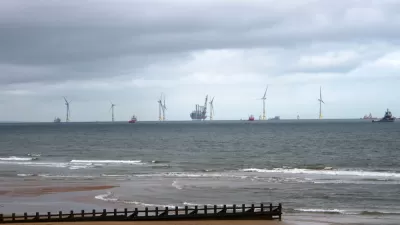The potential for offshore wind power along the Atlantic Coast has moved closer to reality in fits and starts. Recent leases, however, indicate what the future of the industry could looks like.
"Two energy firms will spend more than $1.8 million to potentially develop wind farms in federal waters off the coast of New Jersey," reports Devin Henry.
"The companies — RES America Developments and U.S. Wind Inc.— won the rights in a lease auction on Monday. Combined, the firms bought up leases for nearly 344,000 acres of space, the Department of Interior announced."
The 344,000 acres is located seven miles of the coast of New Jersey, extending about 21 miles into the Atlantic Ocean. Department of the Interior Secretary Sally Jewell is quoted in the article describing the auction as the first step toward a "sustainable offshore wind program" for communities located on the Atlantic Coast.
Following that news, came an announcement this week that Denmark-based DONG Energy A/S, "is proposing what could be North America’s largest offshore wind farm 15 miles south of Martha’s Vineyard…" Jay Fitzgerald reports on that proposal, noting that the plans for 100 wind turbines would more than double the output of the Cape Wind project, which is stalled after a financial setback in January 2015.
DONG has already acquired the lease for the area—one of the offshore stretches approved by the federal government for offshore wind power generation. The next steps in approval, along with construction, are expected to require patience. According to Fitzgerald, "DONG Energy faces lengthy Massachusetts and US permitting processes that include environmental reviews and approvals for where its power lines would come ashore. Once those approvals are in hand, DONG Energy said, it would take about three years to build the wind farm, and the first phase could include 30 to 35 turbines and be in service by early next decade."
FULL STORY: Feds auction 340,000 acres for offshore wind power

Alabama: Trump Terminates Settlements for Black Communities Harmed By Raw Sewage
Trump deemed the landmark civil rights agreement “illegal DEI and environmental justice policy.”

Study: Maui’s Plan to Convert Vacation Rentals to Long-Term Housing Could Cause Nearly $1 Billion Economic Loss
The plan would reduce visitor accommodation by 25% resulting in 1,900 jobs lost.

Why Should We Subsidize Public Transportation?
Many public transit agencies face financial stress due to rising costs, declining fare revenue, and declining subsidies. Transit advocates must provide a strong business case for increasing public transit funding.

Paris Bike Boom Leads to Steep Drop in Air Pollution
The French city’s air quality has improved dramatically in the past 20 years, coinciding with a growth in cycling.

Why Housing Costs More to Build in California Than in Texas
Hard costs like labor and materials combined with ‘soft’ costs such as permitting make building in the San Francisco Bay Area almost three times as costly as in Texas cities.

San Diego County Sees a Rise in Urban Coyotes
San Diego County experiences a rise in urban coyotes, as sightings become prevalent throughout its urban neighbourhoods and surrounding areas.
Urban Design for Planners 1: Software Tools
This six-course series explores essential urban design concepts using open source software and equips planners with the tools they need to participate fully in the urban design process.
Planning for Universal Design
Learn the tools for implementing Universal Design in planning regulations.
Smith Gee Studio
Alamo Area Metropolitan Planning Organization
City of Santa Clarita
Institute for Housing and Urban Development Studies (IHS)
City of Grandview
Harvard GSD Executive Education
Toledo-Lucas County Plan Commissions
Salt Lake City
NYU Wagner Graduate School of Public Service




























